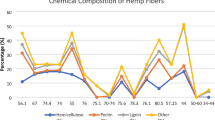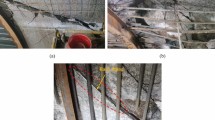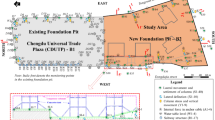Abstract
Karst landscapes are widely distributed in China, and buried karst is widespread in Guangdong. This study mainly focuses on buried karst or karst caves which are underground at depths of up to 50 m and can significantly affect engineering construction activity. The karst caves, which are widely distributed in Guangdong Province, have the following features: high fissure water content, high rock permeability, prone to collapse, variable shapes, and irregular distribution. When a shield tunnel is constructed in this kind of environment, hazards, such as sink holes, the ingress of water or stones, and damage to the constructed tunnels may occur. Thus, karst caves need to be treated before tunnel construction. This paper presents a procedure for karst cave treatment to mitigate possible hazards during shield tunnelling in karst regions. The construction procedure includes field investigation, judgment, treatment, and effectiveness check. The treatment criteria, grouting material, construction steps, and effectiveness check for the karst cave treatment are introduced in detail. A field test on shield tunnelling excavation was conducted using the karst cave treatment in the karst region of Guangzhou, China. Field investigations include testing the unconfined compressive strength (UCS) of borehole samples of grouting materials, standard penetration test (SPT), core recovery (CR), ground surface settlement and building settlement. All of the UCS values of the borehole samples are greater than 0.2 MPa, the modified SPT values are more than ten, and the CR values are greater than 90 %. The measured values of ground surface settlement and building settlement are all within the allowable ranges. All of the test results demonstrate the applicability of this treatment process in karst regions.




















Similar content being viewed by others
References
Fargnoli V, Boldini D, Amorosi A (2013) TBM tunnelling-induced settlements in coarse-grained soils: the case of the new Milan underground line 5. Tunn Undergr Space Technol 38:336–347. doi:10.1016/j.tust.2013.07.015
Guangzhou Metro Design & Research Institute Co., Ltd (GMDRI) (2010) General technical requirement of karst treatment in Guangzhou Metro Line 9 (Trial) (in Chinese)
Gui L (2008) Engineering technique for shield tunnel in karst region of Guangzhou Metro Line 5. J Guilin Univ Technol 28(3):324–329 (in Chinese)
Ju SJ, Zhu WB (2007) Study on geological investigation methods for shield tunneling in mixed ground. Tunn Constr 27(6):10–14 (in Chinese)
Li LP (2009) Study on catastrophe evolution mechanism of karst water Inrush, PhD Thesis. Shandong University, Jinan, Shandong (in Chinese)
Li X, Li Y (2014) Research on risk assessment system for water inrush in the karst tunnel construction based on GIS: case study on the diversion tunnel groups of the Jinping II hydropower station. Tunn Undergr Space Technol 40:182–191. doi:10.1016/j.tust.2013.10.005
Li SC, Zhou ZQ, Li LP, Xu ZH, Zhang QQ, Shi SS (2013) Risk assessment of water inrush in karst tunnels based on attribute synthetic evaluation system. Tunn Undergr Space Technol 38:50–58. doi:10.1016/j.tust.2013.05.001
Liao SM, Peng FL, Shen SL (2008) Analysis of shearing effect on tunnel induced by load transfer along longitudinal direction. Tunn Undergr Space Technol 23(4):421–430. doi:10.1016/j.tust.2007.07.001
Liao SM, Liu JH, Wang RL, Li ZM (2009) Shield tunneling and environment protection in Shanghai soft ground. Tunn Undergr Space Technol 24(4):454–465. doi:10.1016/j.tust.2008.12.005
Lu YR (2010) China karst. Higher Education Press, Beijing (in chinese)
Ma LF (1997) The topographic map of the People’s Republic of China. China Atlas Press, Beijing (in Chinese)
Ma L, Xu YS, Shen SL, Sun WJ (2014) Evaluation of the hydraulic conductivity of aquifers with piles. Hydrogeol J 22(2):371–382. doi:10.1007/s10040-013-1068-y
Shen SL, Xu YS (2011) Numerical evaluation of land subsidence induced by groundwater pumping in Shanghai. Can Geotech J 48(9):1378–1392. doi:10.1139/T11-049
Shen SL, Xu YS, Hong ZS (2006) Estimation of land subsidence based on groundwater flow model. Mar Georesour Geotechnol 24(2):149–167. doi:10.1080/10641190600704848
Shen SL, Horpibulsuk S, Liao SM, Peng FL (2009) Analysis of the behavior of DOT tunnel lining caused by rolling correction operation. Tunn Undergr Space Technol 24(1):84–90. doi:10.1016/j.tust.2008.05.003
Shen SL, Du YJ, Luo CY (2010) Evaluation of the effect of double-o-tunnel rolling-correction via apply one-side block loading. Can Geotech J 47(10):1060–1070. doi:10.1139/T10-013
Shen SL, Wang ZF, Yang J, Ho EC (2013a) Generalized approach for prediction of jet grout column diameter. J Geotech Geoenviron Eng ASCE 139(12):2060–2069. doi:10.1061/(ASCE)GT.1943-5606.0000932
Shen SL, Wang ZF, Sun WJ, Wang LB, Horpibulsuk S (2013b) A field trial of horizontal jet grouting using the composite-pipe method in the soft deposits of Shanghai. Tunn Undergr Space Technol 35:142–151. doi:10.1016/j.tust.2013.01.003
Shen SL, Wang ZF, Horpibulsuk S, Kim YH (2013c) Jet-grouting with a newly developed technology: the twin-jet method. Eng Geol 152(1):87–95. doi:10.1016/j.enggeo.2012.10.018
Shen SL, Wu HN, Cui YJ, Yin ZY (2014) Long-term settlement behavior of the metro tunnel in Shanghai. Tunn Undergr Space Technol 40:309–323. doi:10.1016/j.tust.2013.10.013
Shin HS, Kim CY, Kim KY, Bae GJ, Hong SW (2006) A new strategy for monitoring of adjacent structures to tunnel construction in urban area. Tunn Undergr Space Technol 21:461–462. doi:10.1016/j.tust.2005.12.099
Standing J, Selemetas D (2013) Greenfield ground response to EPBM tunnelling in London Clay. Géotechnique 63(12):989–1007. doi:10.1680/geot.12.P.154
Tan Y, Wang DL (2013a) Characteristics of a large-scale deep foundation pit excavated by central-island technique in Shanghai soft clay. I: bottom-up construction of the central cylindrical shaft. ASCE J Geotech Geoenviron Eng 139(11):1875–1893. doi:10.1061/(ASCE)CF.1943-5509.0000521
Tan Y, Wang DL (2013b) Characteristics of a large-scale deep foundation pit excavated by central-island technique in Shanghai soft clay. II: top-down construction of the peripheral rectangular pit. ASCE J Geotech Geoenviron Eng 139(11):1894–1910. doi:10.1061/(ASCE)CF.1943-5509.0000535
Tóth Á, Gong Q, Zhao J (2013) Case studies of TBM tunnelling performance in rock–soil interface mixed ground. Tunn Undergr Space Technol 38:140–150. doi:10.1016/j.tust.2013.06.001
Wu HN, Huang RQ, Sun WJ, Shen SL, Xu YS, Liu YB, Du SJ (2014) Leaking behaviour of shield tunnels under the Huangpu river of Shanghai with induced hazards. Nat Hazards 70(2):1115–1132. doi:10.1007/s11069-013-0863-z
Xu YS, Shen SL, Cai ZY, Zhou GY (2008) The state of land subsidence and prediction activities due to groundwater withdrawal in China. Nat Hazards 45(1):123–135. doi:10.1061/40867(199)5
Xu YS, Ma L, Shen SL, Sun WJ (2012a) Evaluation of land subsidence by considering underground structures that penetrate the aquifers of Shanghai, China. Hydrogeol J 20(8):1623–1634. doi:10.1007/s11069-012-0220-7
Xu YS, Ma L, Du YJ, Shen SL (2012b) Analysis on urbanization induced land subsidence in Shanghai. Nat Hazards 63(2):1255–1267. doi:10.1007/s11069-012-0220-7
Xu YS, Shen SL, Du YJ, Chai JC, Horpibulsuk S (2013a) Modelling the cutoff behavior of underground structure in multi-aquifer-aquitard groundwater system. Nat Hazards 66(2):731–748. doi:10.1007/s11069-013-0576-3
Xu YS, Huang RQ, Han J, Shen SL (2013b) Evaluation of allowable withdrawn volume of groundwater based on observed data. Nat Hazards 67(2):513–522. doi:10.1061/(ASCE)GT.1943-5606.0000527
Yang YS, Wu H, Xu JF, Yang XQ (2007) Construction of shield tunnel in karst strata. J Railw Eng Soc 7:56–60 (in Chinese)
Yilmaz I (2007) GIS based susceptibility mapping of karst depression in gypsum: a case study from Sivas basin (Turkey). Eng Geol 90(1–2):89–103. doi:10.1016/j.enggeo.2006.12.004
Yuan DX (1976) Karst in China. Shanghai People’s Publishing House, Shanghai (in Chinese)
Zhang Q, Tian S, Mo Y, Dong X, Hao S (1993) An expert system for prediction of karst disaster in excavation of tunnels or underground structures through a carbonate rock area. Tunn Undergr Space Technol 8(3):373–378. doi:10.1016/0886-7798(93)90021-M
Zhao J, Gong QM, Eisensten Z (2007) Tunnelling through a frequently changing and mixed ground: a case history in Singapore. Tunn Undergr Space Technol 22(4):388–400. doi:10.1016/j.tust.2006.10.002
Acknowledgments
The research work described herein was funded by the National Nature Science Foundation of China (NSFC) (Grant Nos. 41372283 and 41472252) and National Basic Research Programme of China (973 Programme: 2015CB057800). These financial supports are gratefully acknowledged.
Author information
Authors and Affiliations
Corresponding author
Rights and permissions
About this article
Cite this article
Cui, QL., Wu, HN., Shen, SL. et al. Chinese karst geology and measures to prevent geohazards during shield tunnelling in karst region with caves. Nat Hazards 77, 129–152 (2015). https://doi.org/10.1007/s11069-014-1585-6
Received:
Accepted:
Published:
Issue Date:
DOI: https://doi.org/10.1007/s11069-014-1585-6




